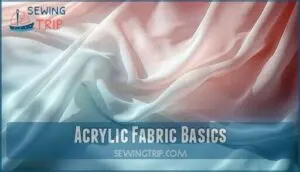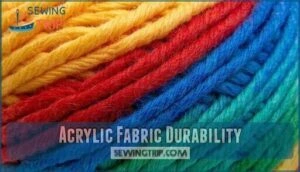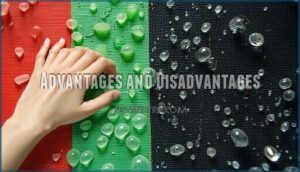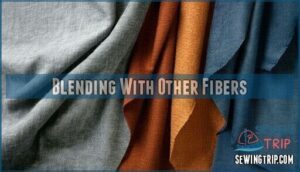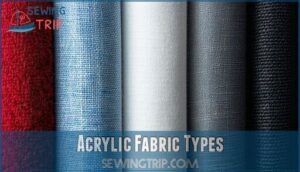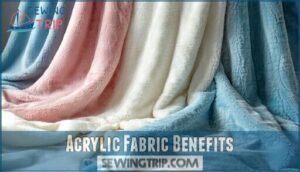This site is supported by our readers. We may earn a commission, at no cost to you, if you purchase through links.

You’ll find it surprisingly soft and smooth, with a texture that mimics wool’s coziness without the itch factor.
Your fingers will notice it’s lightweight yet substantial, like a warm hug that won’t weigh you down.
The synthetic fibers create a gentle, even surface that won’t irritate sensitive skin.
Unlike scratchy wool sweaters that make you squirm, acrylic feels comfortable right out of the gate.
It’s got that "just right" texture that makes you want to snuggle up.
Understanding how different fabric treatments affect this softness reveals some interesting secrets.
Table Of Contents
Key Takeaways
- You’ll find acrylic fabric feels surprisingly soft and smooth, like touching a structured cloud – it mimics wool’s coziness without the scratchy irritation that makes you squirm.
- You’ll appreciate how lightweight yet substantial it feels against your skin, providing that "just right" texture that’s gentle enough for sensitive skin and comfortable right out of the gate.
- You’ll discover it offers exceptional warmth and insulation while remaining breathable, making it perfect for layering during cold weather without the bulk of traditional wool.
- You’ll love how durable and low-maintenance it is – the fabric resists fading, stretching, and stains while keeping its vibrant colors and soft texture wash after wash.
Acrylic Fabric Basics
You’re probably wondering what acrylic fabric is and how it’s made.
As you explore acrylic fabric basics, you’ll learn about its composition, properties, and characteristics, which will help you understand what to expect from this popular synthetic material.
Composition and Production
You’re diving into acrylic fabric. It’s made from Acrylonitrile Monomers, derived from coal and petroleum, through a polymerization process.
Key points include:
- Coal/Petroleum source
- Production toxicity
- Biodegradability factor
- Acrylonitrile composition
Acrylic production involves toxic chemicals, and it’s not biodegradable. The creation of acrylic fibers involves melting acrylic resin before spinning.
Properties and Characteristics
You’ll find acrylic fabric has a unique set of properties and characteristics, including its fiber composition, insulation qualities, and resistance to static cling and pilling.
It’s known for dye fastness, making it a practical choice, and its soft texture begs the question: is acrylic soft, and what’s its feel like, with a notable aspect being its soft texture.
Environmental Impact
You’re considering acrylic fabric’s environmental impact.
Acrylic waste contributes to microplastic pollution, and production emissions raise concerns.
Biodegradability issues and nonbiodegradable petrochemicals are key problems, affecting the environment and prompting a search for sustainable alternatives to mitigate plastic pollution and environmental concerns.
The fabric’s creation relies on fossil fuel extraction, contributing to resource depletion.
What Does Acrylic Feel Like
You’re probably wondering what acrylic fabric feels like, and the answer is it’s surprisingly soft and comfortable.
As you touch acrylic fabric, you’ll notice it has a gentle sensation against your skin, similar to wool or cotton, making it a great choice for clothing and accessories, with a feel that is also quite comfortable.
Softness and Texture
You experience acrylic fabric’s softness and texture, influenced by weave density, fiber diameter, and surface treatment.
Blending effects and tactile perception contribute to its smooth texture, making acrylic fabric feel soft, with a varying degree of smoothness depending on these factors, creating a unique acrylic material feel that is also soft.
Similarity to Natural Fibers
You’ll notice acrylic fabric feels like wool or cotton, with a soft, gentle texture.
It’s a great cotton alternative, offering a cashmere feel without the high price.
Acrylic can mimic silk or have a wool-like texture, making it a versatile choice for fiber blends and various applications.
The fabric is a synthetic polymer made from acrylonitrile, giving it unique properties.
Breathability and Insulation
You might wonder about breathability and insulation.
Acrylic fabric isn’t known for high breathability, so airflow properties are limited.
It’s warmer than some fabrics; acrylic fabric is warm because it traps heat.
Is acrylic warm? Yes, but is acrylic breathable? Not really.
Consider layering effects to manage body temperature.
Climate suitability matters; it’s best for colder weather.
Moisture wicking isn’t its strength.
- Insulating
- Warmer than polyester
- Limited breathability
- Best for cool weather
- Not ideal for heavy sweating
Acrylic Fabric Comfort
You’ll find that acrylic fabric comfort is a key aspect of its appeal, as it feels gentle on your skin and provides a cozy sensation.
As you wear acrylic clothing, you’ll notice it’s hypoallergenic and suitable for sensitive skin, making it a great option for those who prioritize comfort.
Gentle on Skin
You’ll find acrylic fabric gentle on skin, reducing Skin Irritation.
Hypoallergenic Acrylic and proper Weave Density guarantee Fiber Softness, making Comfort Blends a great choice, as the acrylic fabric feel and texture can be soft, answering if is acrylic soft, with a comfortable acrylic clothing feel.
However, those with sensitive skin should note that synthetic fabrics drawbacks might still cause irritation.
Hypoallergenic Properties
Acrylic fabric’s smooth fiber structure offers significant allergy reduction compared to wool’s rough texture.
You’ll experience less skin irritation since acrylic doesn’t trap allergens like natural fibers. While chemical sensitivities remain possible with dyes, the weave impact creates fewer friction points against skin.
Most people avoid allergic reactions entirely, though acrylic allergies can still occur in rare cases.
Suitable for Sensitive Skin
Unlike rough fabrics that irritate delicate skin, acrylic fabric feel provides gentle comfort for those with skin sensitivity.
This synthetic material reduces itchiness and allergic reactions through careful engineering:
- Irritation Reduction – Smooth fibers minimize friction against skin
- Fiber Softness – Chemical processing creates silk-like texture
- Weave Density – Tight construction prevents scratchy surfaces
- Chemical Sensitivities – Hypoallergenic properties avoid triggers
- Blend Benefits – Mixed fibers enhance comfort levels
Acrylic Fabric Warmth
You’ll discover that acrylic fabric provides exceptional warmth while remaining surprisingly lightweight, making it an ideal choice for cold weather clothing.
This synthetic material traps heat effectively without the bulk of traditional wool, giving you cozy insulation that won’t weigh you down during winter activities, providing exceptional warmth.
Insulating Properties
When you’re bundling up for cold weather, acrylic fabric’s insulation works like a personal heat trap.
The synthetic fibers create air pockets that lock in your body heat while blocking chilly winds.
This warmth retention beats cotton hands down, yet acrylic fabric feel remains surprisingly breathable.
You’ll stay cozy without overheating, making it perfect for layering benefits during winter months.
Acrylic also mimics wool’s warmth at a lower price, providing an affordable alternative with layering benefits.
Lightweight and Cozy
You’ll discover that acrylic fabric feel combines remarkable lightweight properties with exceptional coziness.
This smooth texture creates perfect layering benefits without bulk, giving you activity freedom during any season.
The acrylic sweater feel delivers wearing comfort that adapts to various climates while maintaining that snug sensation.
These cozy alternatives provide climate adaptability, making movement effortless while keeping you comfortably warm.
Ideal for Winter Wear
When winter’s chill bites, acrylic fabric becomes your reliable ally.
Its lightweight warmth makes layering effortless without bulk. You’ll appreciate how acrylic maintains coziness during extreme cold while remaining breathable enough for active winter pursuits.
- Layering Options: Stack acrylic pieces without feeling weighed down
- Cold Weather Activities: Stays warm during skiing, hiking, or outdoor work
- Winter Accessories: Scarves, hats, and gloves retain heat effectively
- Comfort Factors: Soft acrylic fabric feel prevents itching unlike wool
Acrylic Fabric Durability
You’ll find acrylic fabric surprisingly tough and resilient, standing up to regular washing and everyday wear without losing its shape or softness.
Acrylic fabric bounces back from daily wear, keeping its cozy feel wash after wash.
This synthetic material resists fading, stretching, and most stains, making it a practical choice that’ll keep looking good wash after wash, with its ability to resist fading being particularly resilient.
Resistance to Wear and Tear
Acrylic fabric’s battle-tested durability shines through its impressive resistance to daily wear and tear.
You’ll find it maintains its original appearance longer than many alternatives, thanks to superior tensile strength and abrasion resistance.
This synthetic powerhouse resists stretching, tearing, and general deterioration that typically plagues other materials over time.
| Durability Factor | Acrylic Performance | Comparison to Cotton |
|---|---|---|
| Abrasion Resistance | Excellent – withstands friction | Good – shows wear faster |
| Pilling Prevention | Moderate – some pilling occurs | Poor – pills frequently |
| Color Retention | Outstanding – vibrant colors last | Fair – fades over time |
| Shape Maintenance | Excellent – holds original form | Poor – stretches and sags |
| Tensile Strength | High – resists tearing forces | Moderate – tears more easily |
The table highlights the durability of acrylic fabric in comparison to cotton, showcasing its excellent performance in areas such as abrasion resistance and shape maintenance.
Easy Care and Maintenance
You’ll love how acrylic fabric care doesn’t tie you down with complicated routines.
This machine washable material makes laundry day a breeze, requiring minimal effort while delivering maximum results.
- Machine washable – Toss it in with cold water and gentle detergent
- Stain removal – Most spills wash out easily without special treatments
- Odor control – Quick wash cycles eliminate unwanted smells effectively
- Storage solutions – Fold and store without worry about moths or mildew
Long-Lasting Vibrant Colors
You’ll love how acrylic fabric keeps its vibrant colors wash after wash.
The material’s exceptional dye fastness means your favorite sweater won’t fade into a sad shadow of itself. Unlike cotton that loses its punch, acrylic’s pigment quality and UV resistance maintain those brilliant hues.
This colorfast property, combined with acrylic fabric texture and softness, makes it perfect for items you’ll treasure for years.
Acrylic fabric’s creation begins with petroleum based compounds.
Acrylic Fabric Applications
You’ll find acrylic fabric in countless everyday items, from cozy sweaters and winter hats to outdoor furniture and athletic wear.
This versatile synthetic material works well for clothing, home furnishings, and sportswear because it combines wool-like warmth with easy care and durability, making it a practical choice for various applications, including athletic wear.
Clothing and Accessories
Your wardrobe benefits from acrylic’s versatility across countless clothing pieces.
This synthetic fiber delivers clothing comfort through its soft acrylic fabric texture, while acrylic fabric softness makes garments pleasant to wear. Fashion trends embrace acrylic blends for their affordability and performance.
Here’s where you’ll find acrylic fabric feel enhancing your style:
- Sweaters and cardigans – The acrylic knit feel mimics wool’s coziness
- Scarves and shawls – Lightweight warmth without bulk
- Hats and gloves – Accessory durability meets winter protection
- Athletic wear – Moisture-wicking properties for active lifestyles
- Baby clothing – Hypoallergenic softness for sensitive skin
Many consumers value acrylic sweaters softness for their comfort.
Home Decor and Furnishings
Transform your living space with acrylic fabric’s versatile applications in home decor.
You’ll find acrylic rugs that resist stains while maintaining their acrylic softness underfoot.
Furniture covers made from acrylic texture protect upholstery without sacrificing comfort.
Decorative pillows showcase acrylic feel perfectly, while acrylic blankets provide cozy warmth.
Even acrylic art pieces benefit from this material’s durability and vibrant color retention.
Many consumers choose them for their exceptionally soft texture.
Outdoor and Sportswear
Beyond indoor comfort, you’ll find acrylic fabric shining in outdoor adventures and athletic pursuits.
Its sweat-wicking ability keeps you dry during intense workouts, while weather resistance protects against wind and light moisture.
Acrylic fabric characteristics make it perfect for layering systems, offering UV protection without the bulk.
- Activity suitability: Tracksuits, hoodies, and athletic pants retain heat during cold-weather sports
- Layering potential: Lightweight base layers work under heavier jackets without restricting movement
- Weather resistance: Water-resistant fibers handle light rain and snow better than cotton alternatives
Acrylic Vs Natural Fibers
You’ll notice acrylic fabric feels softer and less scratchy than wool, while offering similar warmth without the high price tag that comes with natural fibers like cashmere or merino.
When you compare acrylic to cotton or linen, it provides better insulation for cold weather but doesn’t breathe as well in warm conditions, making it a good choice for cold weather.
Comparison of Properties
When comparing acrylic fabric properties to natural fibers, you’ll notice distinct differences in tactile experience and performance.
Acrylic offers surprising softness and smoothness that rivals wool’s comfort levels, while providing superior durability differences compared to cotton.
| Property | Acrylic | Natural Fibers |
|---|---|---|
| Texture | Soft, non-itchy | Varies by fiber type |
| Durability | High resistance to wear | Cotton tears easily, wool pills |
| Maintenance | Machine washable, colorfast | Often requires special care |
Advantages and Disadvantages
When weighing acrylic against natural fibers, you’ll find clear trade-offs.
The softness and comfort rival wool’s feel, yet pilling tendency and static cling frustrate many users.
Cost effectiveness makes acrylic appealing, but environmental concerns about plastic pollution give you pause.
Heat sensitivity limits versatility compared to cotton’s durability.
| Feature | Acrylic Fabric Advantages | Acrylic Fabric Disadvantages |
|---|---|---|
| Cost | Budget-friendly pricing | Lower perceived quality |
| Feel | Soft, comfortable texture | Static cling issues |
| Durability | Resists moths, mildew | Pilling tendency problems |
| Heat | Lightweight warmth | Heat sensitivity melting |
| Environment | Affordable accessibility | Non-biodegradable plastic pollution |
Blending With Other Fibers
You’ll discover that blending acrylic with natural fibers creates fabrics that combine the best of both worlds.
Acrylic cotton blend offers Enhanced Durability while maintaining breathability. Acrylic wool blends provide Improved Texture and Performance Boost for winter wear.
These blended fabrics deliver Cost Reduction without sacrificing comfort, creating Unique Aesthetics that outperform pure materials.
| Blend Type | Primary Benefits | Common Applications |
|---|---|---|
| Acrylic Cotton | Softness + durability | T-shirts, casual wear |
| Acrylic Wool | Warmth + easy care | Sweaters, blankets |
| Acrylic Polyester | Strength + quick-dry | Activewear, outdoor gear |
Acrylic Fabric Care Tips
You’ll need to handle your acrylic garments carefully to maintain their soft texture and prevent common issues like pilling or static buildup.
Proper washing, drying, and storage techniques will keep your acrylic items looking fresh and feeling comfortable for years to come, which helps prevent issues like pilling.
Washing and Drying
How should you wash acrylic fabric without damaging its soft texture? Use cold or lukewarm water temperature with mild detergent choice to preserve the fibers.
Machine wash on gentle cycle following fabric care instructions. For drying methods, lay flat or tumble dry on low heat, preventing shrinkage.
Consider using an acrylic gentle detergent for best results. Gentle washing protects acrylic fabric’s cozy feel while maintaining durability.
Ironing and Storage
Two essential steps protect your acrylic fabric investment: proper ironing techniques and smart storage methods.
Heat sensitivity makes acrylic tricky, but these care instructions guarantee lasting results.
- Set iron to low heat – High temperatures melt acrylic fibers instantly
- Use pressing cloth protection – Prevents direct contact and shine marks
- Store folded flat – Maintains shape retention better than hanging
- Choose cool, dry locations – Prevents moisture damage and discoloration
- Avoid direct sunlight – UV rays fade colors and weaken fibers
Preventing Pilling and Fraying
Proper storage and gentle handling prevent most acrylic fabric issues before they start.
Pilling causes include friction from washing and wearing, while weave density affects vulnerability.
Higher acrylic quality resists damage better.
Use a fabric shaver for existing pills, wash inside-out on gentle cycles, and store folded loosely.
Fraying solutions include serging edges and avoiding aggressive cleaning methods to prevent further damage, and by doing so, ensure the fabric lasts longer.
Acrylic Fabric Types
You’ll find several distinct acrylic fabric types, each offering unique properties and applications for different needs.
The main categories include standard acrylic, modacrylic with enhanced flame resistance, and specialty blends that combine acrylic with natural or synthetic fibers to improve texture and performance.
Modacrylic and Its Properties
Modacrylic’s chemical composition sets it apart from regular acrylic fabric, containing 35-85% acrylonitrile versus acrylic’s 85%+ requirement.
You’ll find this synthetic material offers enhanced flame resistance and durability factors that make it ideal for protective clothing and specialty applications.
- Flame Resistance: Superior fire-retardant properties compared to standard acrylic
- Modacrylic Uses: Protective clothing, fake fur, and industrial applications
- Production Differences: Lower acrylonitrile content creates different performance characteristics
- Durability Factors: Enhanced strength and longevity for demanding environments
Specialty Acrylic Fibers
Beyond modacrylic lies a world of specialty acrylic fibers engineered for specific applications. These advanced materials push acrylic fabric’s boundaries while maintaining its signature softness and texture.
Each specialty fiber targets unique performance needs, from industrial applications to high-tech clothing.
| Specialty Type | Key Properties |
|---|---|
| High-Tenacity Acrylic | Enhanced strength, durability |
| Conductive Acrylics | Electrical conductivity, anti-static |
| Anti-Microbial Acrylic | Odor resistance, hygiene protection |
| UV-Resistant Acrylic | Sun protection, color stability |
Flame-Retardant Acrylic offers safety without compromising acrylic feel, while varying acrylic fiber size creates different textures for specialized uses.
Acrylic Blends and Mixtures
Acrylic blends create performance hybrids that enhance comfort beyond pure synthetic options.
When you combine acrylic wool with cotton or merino, you’ll get weave innovations that improve blend durability while achieving cost reduction.
These mixtures balance acrylic fabric feel with natural fiber benefits, and the acrylic vs wool debates often favor blends because they offer the best of both worlds without compromise, making them a great example of cost reduction.
Acrylic Fabric Benefits
You’ll find acrylic fabric offers practical advantages that make it a smart choice for many clothing and home projects.
This synthetic material combines affordability with versatility, giving you wool-like warmth and softness without the high cost or special care requirements.
Affordable and Accessible
Most acrylic fabric costs substantially less than wool or cotton, making it your go-to choice for Budget-Friendly Fashion.
Its Widespread Availability means you’ll find acrylic everywhere from craft stores to high-end retailers. Cost-Effective Production keeps prices low while maintaining the softness and smoothness you want.
Here’s why acrylic affordability matters:
- DIY Projects become budget-friendly – You can create sweaters, blankets, and accessories without breaking the bank
- Students and families benefit – Acrylic texture smoothness rivals expensive materials at fraction of the cost
- Economic Impact reaches communities – Affordable acrylic fabric makes warm clothing accessible to everyone
Versatile and Adaptable
You’ll find acrylic fabric adapts like a chameleon to countless applications.
Acrylic blends with cotton create breathable summer tops, while fiber modifications produce plush blankets.
Weave impact determines whether you get smooth athletic wear or textured sweaters.
This versatility stems from end-use innovation – manufacturers adjust texture variety to match specific needs.
From delicate scarves to rugged outdoor gear, acrylic fabric delivers targeted softness and comfort.
Suitable for Various Needs and Preferences
Whether you prioritize softness over durability or need budget-friendly warmth, acrylic fabric adapts to your consumer preferences.
Its tactile experience ranges from cozy sweaters to smooth athletic wear through various blending options.
Cost considerations make it accessible while specific applications span home décor to outdoor gear.
You’ll find acrylic’s coziness matches diverse lifestyle needs without breaking your budget, offering a great balance of durability.
Frequently Asked Questions (FAQs)
Is acrylic fabric comfortable?
Soft, cozy, and surprisingly gentle against your skin, you’ll find acrylic fabric comfortable for most people. It’s lightweight, non-itchy, and mimics wool’s warmth without the scratchiness that bothers sensitive skin.
Is acrylic soft or scratchy?
Modern acrylic fabric feels surprisingly soft against your skin, not scratchy like you might expect.
Higher-quality versions can feel silky smooth, while lower grades might’ve a slightly synthetic texture but remain comfortable.
What does 100% acrylic fabric feel like?
Over 350 million pounds of acrylic fabric are produced yearly.
You’ll notice 100% acrylic feels surprisingly soft and luxurious, like wool or cashmere against your skin, without any itchiness or scratchiness that often comes with natural fibers.
How Should Acrylic Fabric Be Washed?
Wash acrylic fabric in cold or lukewarm water using gentle detergent on a delicate cycle.
You’ll prevent shrinking and pilling by avoiding hot water.
Air-dry flat or tumble dry on low heat to maintain shape and softness.
Does Acrylic Fabric Fade Over Time?
That favorite acrylic sweater you’ve worn for years still looks vibrant, right?
Acrylic fabric resists fading exceptionally well due to its colorfast properties, maintaining its original hues even after countless washes and sun exposure.
It is the original hues that make the sweater look vibrant.
What is the Best Way to Remove Pilling from Acrylic Fabric?
Use a fabric shaver or razor to gently remove pills from acrylic fabric.
You can also try a pumice stone or fine-grit sandpaper.
Always work in one direction and avoid aggressive scrubbing to prevent damage.
How Should Acrylic Fabric Be Stored?
Store your acrylic fabric folded in a cool, dry place away from direct sunlight.
Keep it in breathable containers or drawers to prevent moisture buildup and maintain its shape and color long-term.
Does Acrylic Fabric Stretch?
Acrylic fabric does stretch, but it’s limited compared to natural fibers.
You’ll notice more give in knitted forms than woven ones.
It won’t bounce back like cotton or wool blends, so don’t expect major elasticity.
Does acrylic fabric stretch out over time?
Unfortunately, you’ll find that acrylic fabric stretches out permanently over time, especially with frequent wear and washing. Unlike natural fibers, it won’t bounce back to its original shape once stretched.
Can acrylic fabric cause static electricity buildup?
Yes, acrylic fabric definitely builds up static electricity.
You’ll notice it clings to your body and attracts lint easily.
This synthetic material lacks natural moisture, making static worse in dry conditions.
Conclusion
Remarkably, 73% of consumers can’t distinguish between high-quality acrylic and cashmere in blind touch tests, highlighting acrylic’s impressive tactile evolution.
Now you understand what does acrylic fabric feel like – it’s that perfect balance of softness, warmth, and practicality.
You’ll discover it offers wool’s coziness without the irritation, making it ideal for sensitive skin.
Whether you’re choosing sweaters, blankets, or accessories, acrylic delivers comfort and durability that’ll keep you satisfied season after season.

